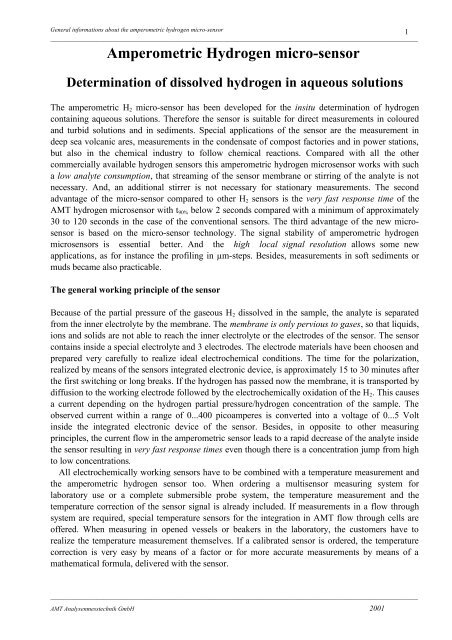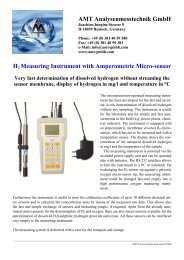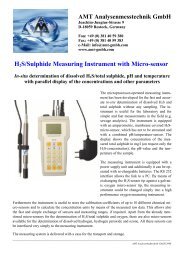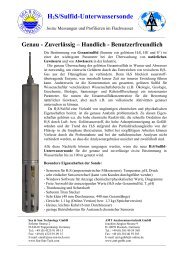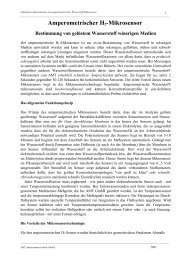Amperometric Hydrogen micro-sensor - AMT Analysenmesstechnik ...
Amperometric Hydrogen micro-sensor - AMT Analysenmesstechnik ...
Amperometric Hydrogen micro-sensor - AMT Analysenmesstechnik ...
You also want an ePaper? Increase the reach of your titles
YUMPU automatically turns print PDFs into web optimized ePapers that Google loves.
General informations about the amperometric hydrogen <strong>micro</strong>-<strong>sensor</strong>________________________________________________________________________________________________<strong>Amperometric</strong> <strong>Hydrogen</strong> <strong>micro</strong>-<strong>sensor</strong>Determination of dissolved hydrogen in aqueous solutionsThe amperometric H 2 <strong>micro</strong>-<strong>sensor</strong> has been developed for the insitu determination of hydrogencontaining aqueous solutions. Therefore the <strong>sensor</strong> is suitable for direct measurements in colouredand turbid solutions and in sediments. Special applications of the <strong>sensor</strong> are the measurement indeep sea volcanic ares, measurements in the condensate of compost factories and in power stations,but also in the chemical industry to follow chemical reactions. Compared with all the othercommercially available hydrogen <strong>sensor</strong>s this amperometric hydrogen <strong>micro</strong><strong>sensor</strong> works with sucha low analyte consumption, that streaming of the <strong>sensor</strong> membrane or stirring of the analyte is notnecessary. And, an additional stirrer is not necessary for stationary measurements. The secondadvantage of the <strong>micro</strong>-<strong>sensor</strong> compared to other H 2 <strong>sensor</strong>s is the very fast response time of the<strong>AMT</strong> hydrogen <strong>micro</strong><strong>sensor</strong> with t 90% below 2 seconds compared with a minimum of approximately30 to 120 seconds in the case of the conventional <strong>sensor</strong>s. The third advantage of the new <strong>micro</strong><strong>sensor</strong>is based on the <strong>micro</strong>-<strong>sensor</strong> technology. The signal stability of amperometric hydrogen<strong>micro</strong><strong>sensor</strong>s is essential better. And the high local signal resolution allows some newapplications, as for instance the profiling in µm-steps. Besides, measurements in soft sediments ormuds became also practicable.The general working principle of the <strong>sensor</strong>Because of the partial pressure of the gaseous H 2 dissolved in the sample, the analyte is separatedfrom the inner electrolyte by the membrane. The membrane is only pervious to gases, so that liquids,ions and solids are not able to reach the inner electrolyte or the electrodes of the <strong>sensor</strong>. The <strong>sensor</strong>contains inside a special electrolyte and 3 electrodes. The electrode materials have been choosen andprepared very carefully to realize ideal electrochemical conditions. The time for the polarization,realized by means of the <strong>sensor</strong>s integrated electronic device, is approximately 15 to 30 minutes afterthe first switching or long breaks. If the hydrogen has passed now the membrane, it is transported bydiffusion to the working electrode followed by the electrochemically oxidation of the H 2 . This causesa current depending on the hydrogen partial pressure/hydrogen concentration of the sample. Theobserved current within a range of 0...400 picoamperes is converted into a voltage of 0...5 Voltinside the integrated electronic device of the <strong>sensor</strong>. Besides, in opposite to other measuringprinciples, the current flow in the amperometric <strong>sensor</strong> leads to a rapid decrease of the analyte insidethe <strong>sensor</strong> resulting in very fast response times even though there is a concentration jump from highto low concentrations.All electrochemically working <strong>sensor</strong>s have to be combined with a temperature measurement andthe amperometric hydrogen <strong>sensor</strong> too. When ordering a multi<strong>sensor</strong> measuring system forlaboratory use or a complete submersible probe system, the temperature measurement and thetemperature correction of the <strong>sensor</strong> signal is already included. If measurements in a flow throughsystem are required, special temperature <strong>sensor</strong>s for the integration in <strong>AMT</strong> flow through cells areoffered. When measuring in opened vessels or beakers in the laboratory, the customers have torealize the temperature measurement themselves. If a calibrated <strong>sensor</strong> is ordered, the temperaturecorrection is very easy by means of a factor or for more accurate measurements by means of amathematical formula, delivered with the <strong>sensor</strong>.1________________________________________________________________________________________________<strong>AMT</strong> <strong>Analysenmesstechnik</strong> GmbH 2001
General informations about the amperometric hydrogen <strong>micro</strong>-<strong>sensor</strong>2________________________________________________________________________________________________The advantages of the <strong>micro</strong>-<strong>sensor</strong> technologyFor manufacturing the amperometric H 2 <strong>sensor</strong> a special geometric design has been choosen to builta real <strong>micro</strong>-<strong>sensor</strong>. Electrode diameters below 25 µm, a very thin special membrane with smalldiameters, extremly short diffusion distances for the hydrogen to the working electrode and anegligible analyte consumption at the electrodes leading finally to response times (t 90% ) of less than 2seconds. The analyte consumption effects are negligible too, so that streaming of the <strong>sensor</strong>membrane and stirring is not necessary. Besides, the dimensions of the sensitive tips within a rangeof some <strong>micro</strong>meters allow insitu measurements without destroying equilibriums, concentrationgradients and geometrical structures. This is very important, if measurements in muddy sedimentsare required.Technical data for all H 2 -<strong>micro</strong>-<strong>sensor</strong> heads independent from the <strong>sensor</strong>design *) measuring principle: amperometric membrane covered <strong>micro</strong><strong>sensor</strong> 3 <strong>sensor</strong> electrodes exchangeable <strong>sensor</strong> head necessary time for the first polarization: approx. 15-30 minutes streaming of the membrane or stirring is not necessary, low analyte consumption suitable for the determination of concentration gradients with high local resolution measuring ranges: 0,0002....3 mg/l H 2others on request accuracy of the <strong>sensor</strong>:: better than 2% of the measuring value temperature range: 0°C to 30°C response times: t 90% : below 2 seconds average life time: approximately 6-10 months, may be influenced by the samples matrix pressure stability: laboratory <strong>sensor</strong> orshallow water version for pressures of up to 10 bar or housing: all housings made of titanium*) Changes for technical improvement are reserved.________________________________________________________________________________________________<strong>AMT</strong> <strong>Analysenmesstechnik</strong> GmbH 2001
General informations about the amperometric hydrogen <strong>micro</strong>-<strong>sensor</strong>3________________________________________________________________________________________________Sensor designs of amperometric H 2 <strong>micro</strong>-<strong>sensor</strong>s1.) Laboratory <strong>micro</strong><strong>sensor</strong> with integrated electronic deviceThis <strong>sensor</strong> has been developed for the laboratory and simple field use and has to be combined withone of the offered measuring devices. The <strong>sensor</strong> consists of a titanium housing, a waterproofconnection with the cable (IP 68), an exchangeable <strong>sensor</strong> head and a removable protection cage (onyour own risk - no guarantee in the case of mechanical destruction). This <strong>sensor</strong> could be equippedboth with the hydrogen <strong>sensor</strong> head and with a galvanic oxygen <strong>sensor</strong> head. Other concentrationranges can be delivered on request. The exchange of the <strong>sensor</strong> head is very easy by pull off andpush on. Please take note, that no liquid can get in to the plug connection when changing the <strong>sensor</strong>head.2.) Shallow water <strong>micro</strong><strong>sensor</strong> for probe systemsThe shallow water <strong>sensor</strong> has been developed for use in combination with so called CTD-probesystems up to depths of 70 meters. Therefore every shallow water <strong>sensor</strong> is equipped with a specialunderwater connector, type wet con BH-4-MP. Further characteristics are the integrated electronicdevice, the titanium housing and the exchangeable <strong>sensor</strong> head. This <strong>sensor</strong> could be equipped bothwith the hydrogen <strong>sensor</strong> head and with a galvanic oxygen <strong>sensor</strong> head. Other concentration rangescan be delivered on request. The exchange of the <strong>sensor</strong> head is very easy by pull off and push on.Please take note, that no liquid can get in to the plug connection when changing the <strong>sensor</strong> head.________________________________________________________________________________________________<strong>AMT</strong> <strong>Analysenmesstechnik</strong> GmbH 2001
General informations about the amperometric hydrogen <strong>micro</strong>-<strong>sensor</strong>4________________________________________________________________________________________________Use of amperometric H 2 <strong>micro</strong>-<strong>sensor</strong>s1. Laboratory use: laboratory <strong>sensor</strong> with integrated electronic device+ measuring device with cable+ temperature <strong>sensor</strong>2. Field measurements(up to 1 m water depth):3. Online insitu measurements(up to 100 meter water depth)a) laboratory <strong>sensor</strong> with integrated electronic device+ measuring device with cable+ temperature <strong>sensor</strong>b) H 2 -probe with <strong>sensor</strong>s for H 2 (shallow water version),pressure (depth), temperature+ multi-core sea-cable+ notebook/personal computer+ softwarea) H 2 -probe with <strong>sensor</strong>s for H 2 (shallow water version),pressure (depth), temperature+ multi-core sea-cable+ notebook/personal computer+ software orb) Interfacing of a H 2 shallow water <strong>sensor</strong> to alreadyexisting probe systems, provided that the probesystem contains one more free channel and is quippedalready with <strong>sensor</strong>s for temperature and pressure+ integration of the mathematical formula for thecalculation of the dissolved hydrogen amount intothe probe's software________________________________________________________________________________________________<strong>AMT</strong> <strong>Analysenmesstechnik</strong> GmbH 2001


